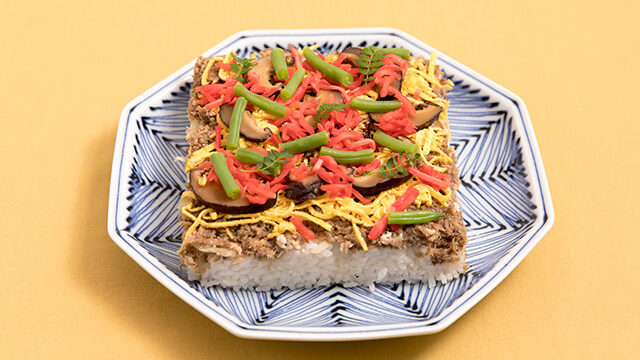
Alright, let’s journey to the Tango region of Kyoto Prefecture and discover a vibrant and flavorful dish called Bara-zushi. This isn’t your typical sushi roll; it’s a scattered sushi that celebrates the local ingredients, especially the mackerel. It’s a dish with history and tradition, so let’s explore its delicious details.
Dish Name: Bara-zushi
- Region / Location: Tango region, Kyoto Prefecture
- Primary Area of Tradition: Tango region
- Main Ingredients: Rice, vinegar, mackerel, dried shiitake mushrooms, eggs, kanpyo (dried gourd strips), kamaboko (fish cake), bamboo shoots, red pickled ginger
How It’s Eaten / Served
In a shallow wooden box called a “matsubuta,” a thin layer of sushi rice is spread. On top of this, flaked mackerel, simmered in a sweet and savory sauce, is scattered, along with colorful ingredients like dried shiitake mushrooms, thin strips of egg, kamaboko, red pickled ginger, and seasonal vegetables. It can be made in a single layer, but sometimes it’s layered with sushi rice and ingredients for a beautiful cross-section when cut. Bara-zushi is portioned and served by cutting it into squares.
Cultural Background and Preservation
In the Tango Peninsula, facing Wakasa Bay, mackerel was abundant and has been a popular fish since ancient times. Because refrigeration technology was not well-developed, people devised ways to enjoy mackerel for longer periods. “Heshiko,” mackerel pickled in salt and then in rice bran, is one such dish. Roasting was also a method of preservation. When transporting goods from Wakasa Bay to the capital (Kyoto) along the “Mackerel Road,” mackerel was roasted or salted for inland transport. As a result, there are many local dishes using roasted mackerel around the Mackerel Road.
Bara-zushi is one such local dish using roasted mackerel, characterized by the use of flaked mackerel and a variety of colorful toppings. Unique utensils are used, such as the “matsubuta” (a shallow wooden box), “sushi kiri” (a spatula for portioning Bara-zushi), and “baratetsuki” (a flat basket).
While locals often simply call it “Bara-zushi,” its formal name is “Tango Bara-zushi.” The name “Bara-zushi” likely comes from the way the ingredients and flaked mackerel are “barabara” (scattered) over the sushi rice. Another theory suggests it comes from mixing the sushi rice with a flat basket called a “baratetsuki.”
In the past, mackerel was simmered for a long time to make the flaked mackerel, but canned mackerel is often used today. For this reason, extra-large cans of mackerel, not seen in other regions, are sold in local supermarkets.
Bara-zushi is still eaten today at celebrations such as festivals and weddings. It’s also a staple at events like the Doll Festival, sports days, New Year’s, the Obon festival, and birthdays, where many people gather.
Bara-zushi has been passed down within families, from mother to grandmother, and is still made for celebratory occasions. It’s also available in school lunches and can be purchased at restaurants and supermarkets.
In recent years, events where people can experience making Bara-zushi have been held at tourist facilities and local events.
Additional information:
- Bara-zushi (ばらずし): A type of scattered sushi, where ingredients are arranged over a bed of sushi rice.
- Tango (丹後): The northernmost region of Kyoto Prefecture.
- Wakasa Bay (若狭湾): A bay on the coast of Fukui and Kyoto Prefectures.
- Heshiko (へしこ): A local dish of fish (often mackerel) pickled in salt and rice bran.
- Mackerel Road (鯖街道): A network of routes used to transport fish, especially mackerel, from the coast to the inland areas.
- Matsubuta (まつぶた): A shallow wooden box used for preparing and serving sushi.
- Kanpyo (かんぴょう): Dried strips of gourd, often used in sushi.
- Kamaboko (かまぼこ): A type of cured fish cake.
- Obon (お盆): A Japanese Buddhist festival to honor the spirits of one’s ancestors.
The information about regional cuisine featured on this website (Piggy's Grandma of Japan) is summarized and adapted from the Ministry of Agriculture, Forestry and Fisheries of Japan (MAFF) website, "Our Regional Cuisines"Additional commentary is provided based on the unique experiences and perspectives of the site's editors.
The copyright for the original content regarding regional cuisine belongs to the Ministry of Agriculture, Forestry and Fisheries of Japan.
The summaries and adaptations published on this site are intended for informational purposes only. Piggy's Grandma of Japan does not guarantee the accuracy or completeness of this information. For the most accurate and complete details, please refer to the original pages on the MAFF website.

